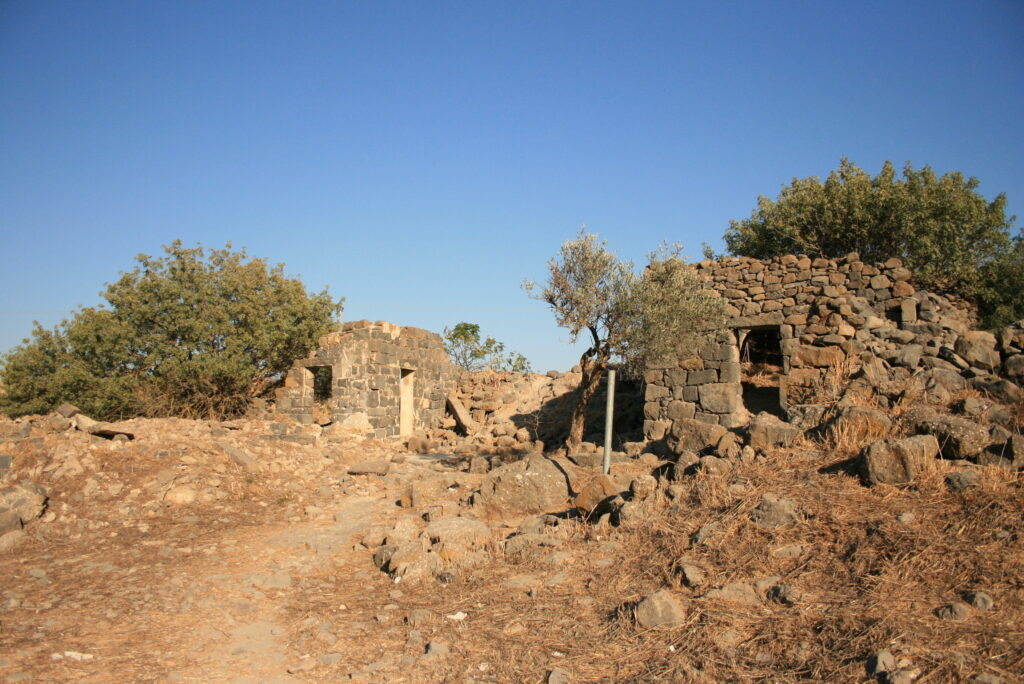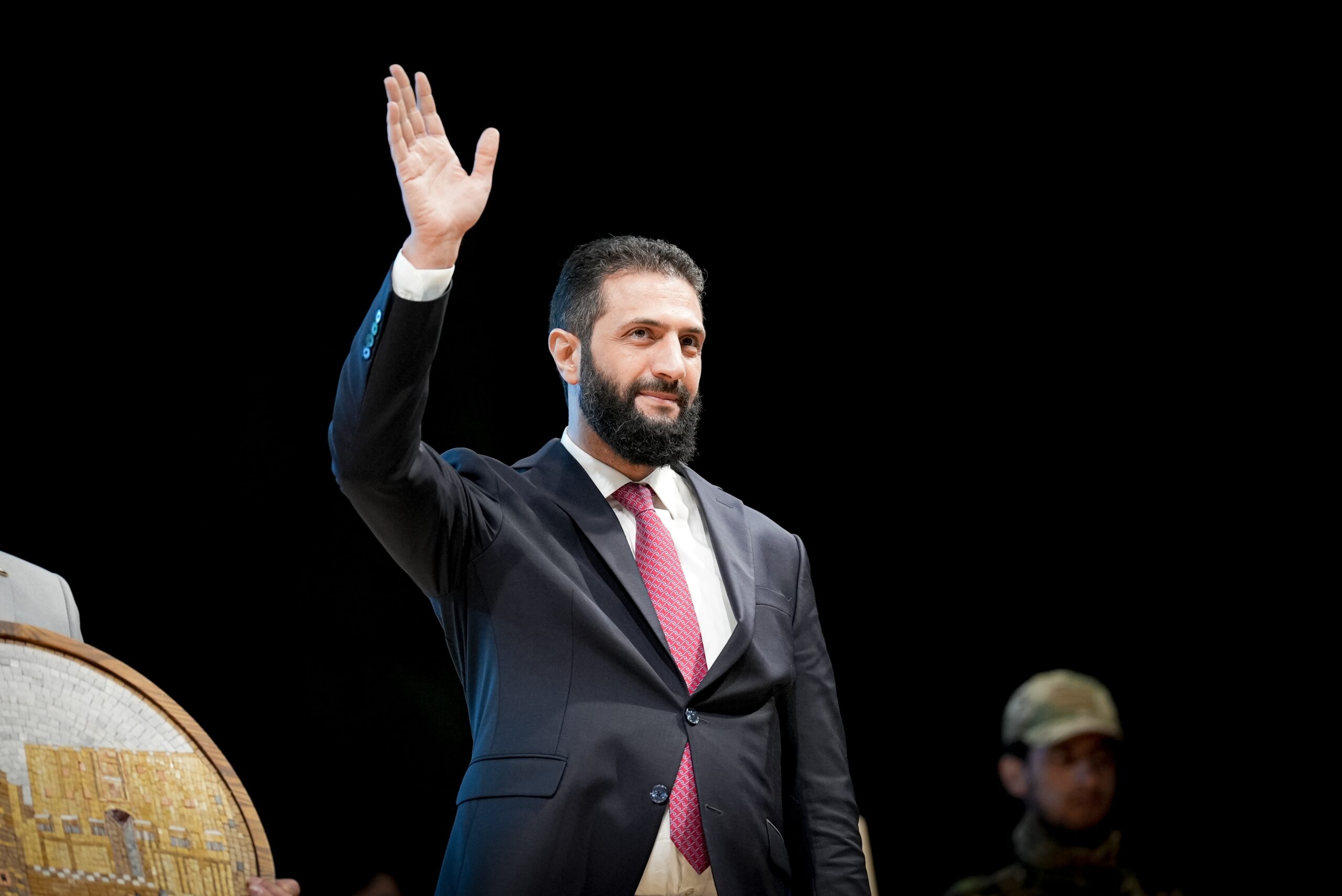Little is known about the past of the Islamist, Ahmed al-Sharaa. Still, his dramatic rise to Syria’s presidency has brought unexpected attention to a long-abandoned village in the Golan Heights with deep biblical and Jewish connections. His former name, al-Julani, hints at his family’s history in the Golan. A little bit of digging reveals that his family’s ancestral home is a village with deep Jewish and Christian roots connecting the city to the Biblical Prophet Elisha.
Born in 1982 in Saudi Arabia, al-Sharaa spent his early years there before his family returned to Syria in 1989. However, his father’s ancestral home lies in the now-abandoned village of Fiq in the Golan Heights, where the family reportedly owned substantial portions of the village lands.
Fiq occupies a site of remarkable biblical significance, believed by scholars to be the ancient Aphek mentioned in Hebrew scriptures. The prophet Elisha specifically referenced this location in his prophecy: “The arrow of the Lord’s deliverance and the arrow of deliverance from Syria; for you must strike the Syrians at Aphek till you have destroyed them” (2 Kings 13:17).
This ancient prophecy carries profound irony given al-Sharaa’s modern Syrian leadership.
During Late Antiquity, Fiq flourished as a remarkably diverse community where Christians, Jews, and pagans coexisted. The archaeological record reveals this multicultural heritage through extensive inscriptions in Latin and Greek scattered throughout the site. These discoveries paint a picture of a thriving settlement where different faiths maintained their distinct identities while sharing common ground.
Among the most significant Christian artifacts is an inscription carved into basalt, believed to have been part of a church or chapel dedication. This inscription mentions key ecclesiastical figures, including a bishop, presbyter, and deacon, indicating a well-organized Christian community. Another inscription appears to reference passages from the Psalms, suggesting the integration of biblical texts into daily life.

The Jewish presence in ancient Aphek is perhaps most dramatically illustrated by the discovery of a Byzantine-era column that once stood in the local synagogue. This remarkable artifact bears a seven-branched menorah and shofar carved into its surface, accompanied by an Aramaic inscription reading “I am Judah the cantor.” This personal signature provides an intimate glimpse into the life of a Jewish religious leader who served his community nearly fifteen centuries ago.
The column represents more than mere religious symbolism—it offers evidence of a structured Jewish community with formal religious roles and established worship practices. The title “cantor” indicates sophisticated liturgical traditions, suggesting that Fiq’s Jewish residents maintained strong connections to broader Jewish scholarship and practice.
Beyond the synagogue column, numerous ruins throughout Fiq display Jewish symbols carved into stone. Stars of David and additional menorahs appear on various structures, creating what amounts to an outdoor museum of Jewish material culture. These symbols, etched permanently into the local architecture, served as public declarations of faith and community identity.
The abundance of Jewish symbols suggests that the community felt secure enough to display their religious identity openly, indicating a level of tolerance and stability in the ancient settlement. The quality and quantity of these carvings also point to a prosperous community with the resources to invest in permanent religious and cultural expression.
The Jewish presence at ancient Aphek extends beyond archaeological artifacts into textual evidence. Mishnaic and Talmudic sources specifically reference Jewish life in this location, providing scholarly validation for what the stones reveal. These ancient Jewish texts treat Aphek as a known Jewish settlement, suggesting it held sufficient importance to warrant mention in rabbinic literature.
This documentary evidence helps establish continuity between the biblical Aphek and the later Jewish community, indicating that Jewish presence in the area may have persisted across multiple historical periods despite political and cultural upheavals.
Fiq’s religious character underwent dramatic transformations reflecting broader regional patterns. While maintaining its multicultural character through Late Antiquity and into the early medieval period, the village became a prominent Christian center during the 13th century. However, by the 15th century, Fiq had become entirely Muslim, completing a religious transformation that mirrored demographic shifts throughout the Levant.
This evolution from a biblical Jewish site to a diverse Late Antique settlement to a Christian center to a Muslim village illustrates the complex layers of religious history embedded in Middle Eastern landscapes. Each community built upon the foundations left by its predecessors while adapting the space to its own spiritual and cultural needs.

Al-Sharaa’s ancestral connection to Fiq occurs against the backdrop of Syria’s largely vanished Jewish community. Modern Syria contains virtually no Jewish residents, yet Jewish history in the region stretches back millennia to the time of King David. Damascus once hosted a vibrant Jewish quarter in the southeastern section of the Old City, complete with synagogues, schools, and family homes that formed the heart of community life.
The ancient historian Josephus, writing in 70 CE, noted the significant Jewish presence throughout the region: “the Jewish race, while dispersed in considerable numbers among native populations throughout the world, is especially numerous in Syria, because of its proximity” to the ancient Jewish homeland. This proximity created lasting cultural, religious, and potentially genetic connections that may persist in unexpected ways.
Claims of concealed Jewish ancestry among prominent Arab figures have surfaced periodically throughout modern history. Most notably, Libya’s former dictator Muammar Gaddafi faced persistent allegations about Jewish maternal ancestry. His chief of protocol, Nuri al-Mismari, claimed that Gaddafi’s mother was Jewish, though documentary evidence for this assertion remains elusive.
In 2010, two Israeli women of Libyan-Jewish origin claimed familial relationships with Gaddafi, with one asserting she was his second cousin through shared ancestry. While these claims were never definitively proven, they highlight the complex ethnic and religious heritage often obscured by modern political boundaries and sectarian conflicts.
Tzvi MiSinai, who has devoted himself to investigating the Jewish roots of Palestinians. He claims that up to 90 percent of the Palestinians in Israel, as well as Gaza and Jordan, are descended from Jews. His travels around Israel and discussions with Palestinians revealed that many of them are aware of their Jewish roots but choose to remain silent.
According to his research, many Jews were allowed to remain in the land of Israel after the Roman conquest to work the land and supply Rome with grain and olive oil. Some of the ancestors of the Palestinians partially converted to Christianity during the Byzantine era. Later, with the coming of Islam, they were Islamized through a combination of mainly forced conversions, most notably at the end of the 11th century. Many held onto their Jewish heritage and continued to practice Judaism secretly. MiSinai bases his theory on historical reports as well as testimonies from Bedouins and Palestinians. He also backs this up with several genetic studies.
MiSinai claims that many Palestinian leaders are descended from Jews. This list includes Ismail Haniyeh, the head of Hamas, Khaled Mashal, a Palestinian leader of Hamas who now resides in Qatar, and even Mahmoud Abbas, the president of the Palestinian Authority (PA).
Whether al-Sharaa possesses Jewish ancestry through his Golan roots remains a matter of speculation rather than established fact. However, his family’s demonstrable connection to historically Jewish lands adds a compelling dimension to discussions about identity, heritage, and the hidden histories that shape modern Middle Eastern politics.
The story of Fiq—from biblical Aphek to the ancestral home of a modern Syrian leader—illustrates how ancient roots can surface unexpectedly in contemporary events. The village’s stones, inscriptions, and archaeological treasures preserve memories of communities long vanished, yet their cultural and genetic legacy may persist in ways both subtle and surprising.
In a region where political rhetoric often emphasizes division and difference, the multicultural heritage of places like Fiq serves as a reminder of more complex historical realities. The shared stones of ancient synagogues, churches, and mosques suggest possibilities for understanding that transcend contemporary boundaries, even as political realities make such connections increasingly difficult to acknowledge or explore.




